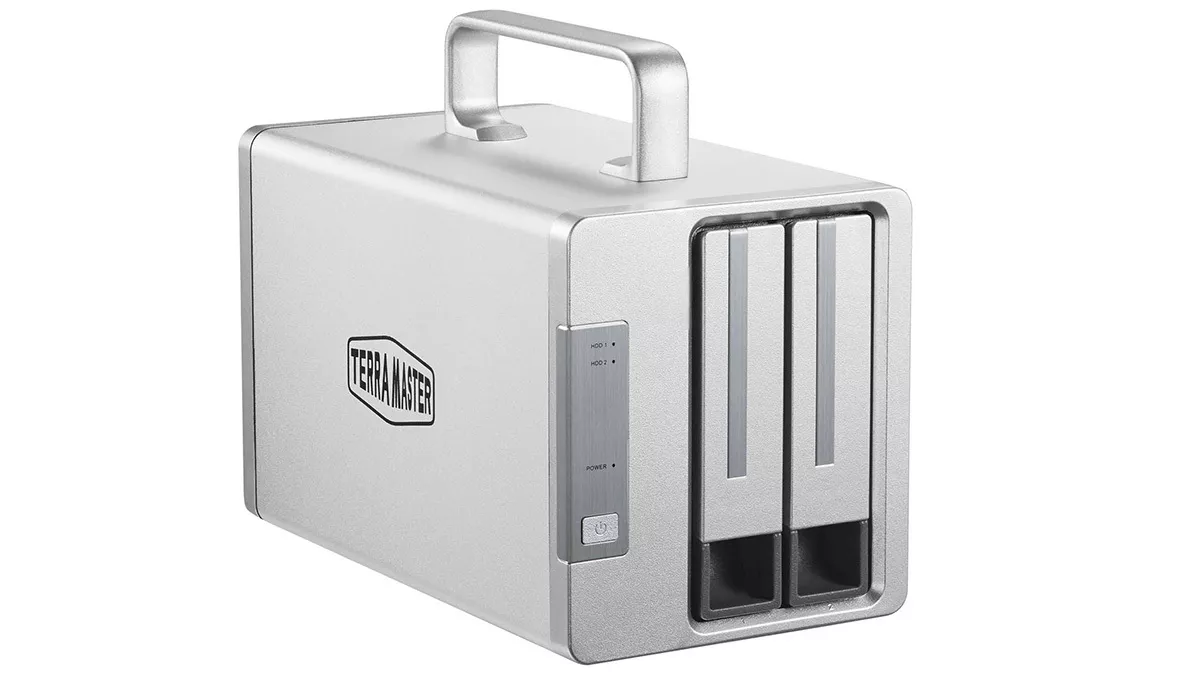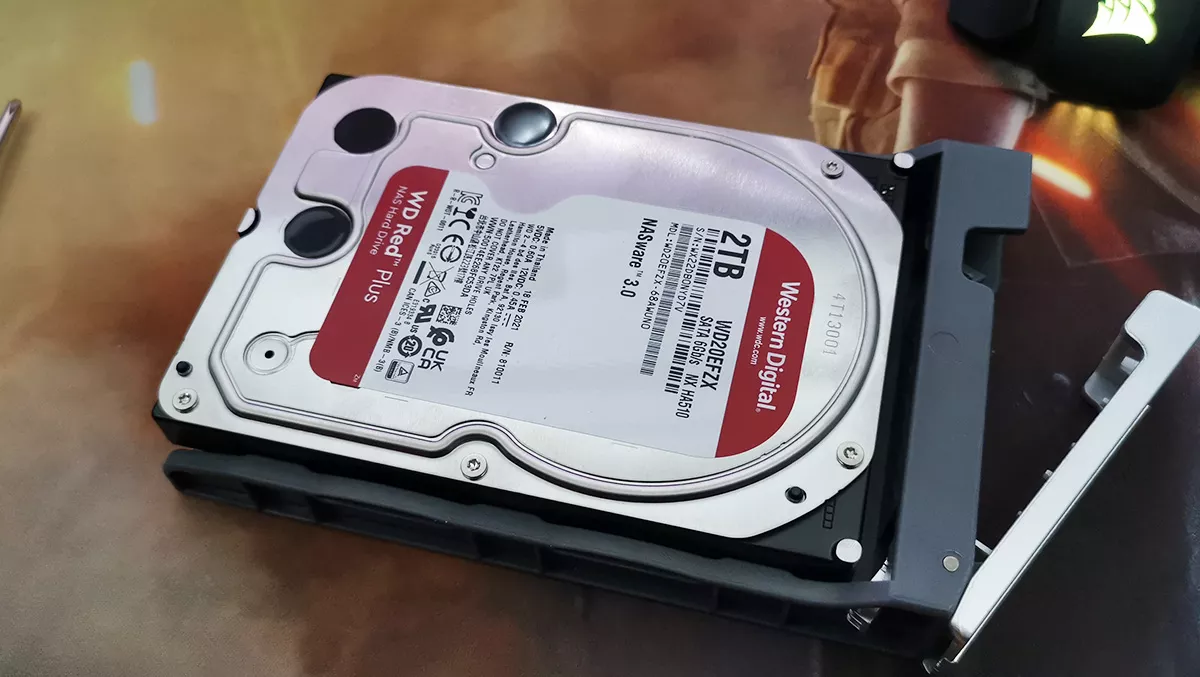
Hands-on review: Terra Master TD2 Thunderbolt 3 2-Bay DAS
Terra Master's TD2 Thunderbolt 3 2-Bay direct-attached storage box is designed with the creative professional in mind. Users can add two drives, be them regular hard drives or solid-state drives in either 2.5" or 3.5" form factors. Once installed, they can be set up either as a RAID or as single disks.
Be it data storage for a large project, or sampling an extension of PC or Mac internal data Terra Master's TD2 offers users the choice between data redundancy or high-performance data access. The aluminium chassis houses two drives which are screwed into removable, easy to access, caddies.
The device does not come with any drives, which will need to be purchased separately. This offers users the choice of drive type and manufacturer according to usage and budget. The kit comes with all the screws you need for the installation of 2.5" and 3.5" drives. It even comes with a screwdriver.
The back of the device has two Thunderbolt 3 sockets and a tiny dial for selecting the DAS format type. There's also a reset point for reinitialising the device once the format has been selected. Terra Master has included a tiny screwdriver for selecting the configuration and a pin for the reset button.
The TD2 feels robust and looks rather smart. The carry handle allows it to be easily moved about. There's also a visible cooling at the back fan for keeping your drives nice and cool.

Being a Thunderbolt 3 device, the TD2 can be daisy-chained with other Thunderbolt devices. The downside of this is that, whilst common with Apple products, not all PCs and Laptops have Thunderbolt 3 functionality. This is improving, and I'm finding most laptops now seem to have Thunderbolt 3 sockets as well as regular USB-C sockets.
Every once in a while, a device turns up for review that misbehaves. I've tested a few Terra Master devices in the past and have had no trouble at all with them. The same can't be said for the TD2 Thunderbolt 2-bay direct-attached storage.
The set-up should be painless. Following the instructions, you install your drives, connect up the unit to your device and switch it on. The drives initialise in whatever RAID set-up you've chosen and then appear on your computer for formatting. Unfortunately, the drives, which I'd used to test another TM product without issues, were not registering with the TD2.
Contrary to the manual, the Terra Master boffins suggested that I switch the device on, connect it to a PC without any drives and then insert a drive. Low and behold, the drive engaged. I did the same with the other one with similar success. Bizarre, but I got there in the end.
The TD2 allows users to select from several drive configurations. The configuration depends on speed, capacity, and data redundancy needs.
The dial on the back of the TD2 allows for selection from Single, Raid 0, RAID 1, and JBOD configurations. Selection is easy, you just rotate the dial to the required configuration with the tiny included screwdriver and use the pin tool to push the recessed reset button for five seconds until the drives reconfigure. It's worth noting that all data on the drives is destroyed when changing configurations.
The simplest drive configuration is to set up both drives as single storage drives. This keeps the drives separate physical disks, just as they would be if just installed in a computer. There are no data redundancy or data access performance advantages.
RAID 0 (RAID being "redundant array of inexpensive disks" or "redundant array of independent disks") combines the drives and stripes data across both disks. The advantage of this is an increase in performance.
RAID 1 creates two identical copies of the data on both drives. This means that if data is corrupted on one drive, or the disk fails entirely, important data can still be accessed from the duplicate on the other drive. The downside of this is that the drive capacity is halved (as two copies of each bit of data are stored across the two drives in the TD2).
JBOD (being "just a bunch of drives"), lumps both drives together as if one physical drive. There's no performance advantage or data redundancy, you just get one big drive with the capacity of both the installed drives.
Using RAID 0 to maximise drive performance and RAID 1 to provide data redundancy for important files allows users to tailor the configuration to their needs. I'm not 100% sure why you'd need to use JBOD over RAID 0, but single may be useful if you want to copy or clone data from one drive to another for use elsewhere.
To see what the implications of each drive configuration had on performance, I tested the data access speed using CrystalDiskMark 8.0.4. Two identical 2TB Western Digital Red Plus SATA 6 NAS hard drives were installed in the Terra Master TD2 for the test.
For the single drive configuration, the test recorded a maximum read speed of 197.2 MB/s and a 174.24 MB/2 write speed. This is about the same as the speeds that you would get if the hard drives were installed directly inside a PC.
For RAID 0, as should be expected, the data speeds increased to 371.37 MB/a read and 357.70 MB/s write. This is due to data being split across the drives and accessed/written to both simultaneously.
RAID 1 had the maximum data transfers speeds of 178.57 MB/s read and 180 MB/s write. The maximum speed for the sequential test 8 tasks in sequence on thread 1 (SEQ1M Q8T1) was 118.90 MB/s and it was the SEQ1M Q1T1 test that scored 178.57 MB/s. The access to random data was also a bit low. Generally, though I'd expect these speeds to be about the same as the single drive configuration.
The JBOD results were 192.64 MB/s read speed and 182.46 MB/s for write. Again, these speeds are almost the same as the single disk configuration, as they are effectively operating in the same way.

The TD2 configurations perform pretty much with textbook results, giving users an easy self-contained RAID setup in a few minutes. The advantage of using a TD2 for your RAID set-up is that not only can it be used with multiple PCs and portable data storage, but the configuration of the device also presents no risk to data storage internally on your PC/Mac.
Aside from the teething problems to start with, the Terra Master TD2 Thunderbolt 3 2-Bay DAS proved to be a relatively painless way to create a semi-portable and versatile data storage solution. The TD2 is a stylish and easy-to-use-solution for those wanting safer data storage or better data access performance for their Thunderbolt 3 compatible devices.


